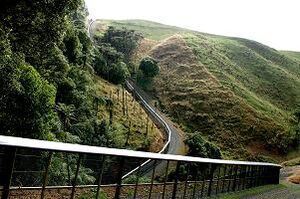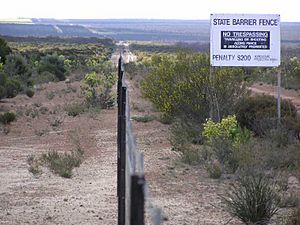Pest-exclusion fence facts for kids

A pest-exclusion fence is a special barrier built to keep certain unwanted animals out of an area. These fences help protect plants, keep grasslands safe for grazing animals, or stop animals that carry diseases from reaching farm animals. They can also protect rare native animals in nature reserves. These fences aren't always just wire. They can also use sounds or smells to keep pests away.
Contents
How These Fences Are Built
Fences are designed to keep specific animals out. This means they can be built in many different ways. The height of the fence, how deep it goes into the ground, and the size of its holes (mesh size) are all important. It's also key to use materials that animals can't climb. Sometimes, part of the fence needs to be buried underground. This stops animals from digging underneath it.
Cool Examples of Fences
- The fence at the Orokonui Ecosanctuary in Waitati, New Zealand, is 1.9 meters (about 6 feet) high. It's made to keep out all introduced mammals. This includes possums, rats, stoats, ferrets, and even mice. The fence uses stainless steel mesh that goes into the ground. This forms a "skirt" that stops animals from burrowing under it. At the top, there's a curved steel hood. This stops climbers like cats and possums from getting over.
- In Queensland, Australia, farm fences are between 1.6 and 2 meters high. They often have barbed wire at the top. Below that, they use ring-lock or hinge-joint wire. This wire has smaller holes at the bottom and slightly larger ones at the top. A part of this mesh lies flat on the ground outside the fence. This "skirt" helps keep animals from getting through.
- In Africa and Asia, people use different fences to keep elephants away from crops. These can be electric fences, fences made of cacti, ropes covered in chili, or even fences with beehives. The sound of upset bees can also scare elephants away.
Pest Fences in Australia
Australia has used exclusion fences since the 1860s.
Long Barrier Fences
The most famous fences in Australia are the very long barrier fences. These are built to keep specific animals out of huge parts of the country. The best-known ones are the Dingo Fence and the Rabbit-proof fence. But there are many others too.
Farm Fences
More recently, farmers have built pest-exclusion fences around their own properties or groups of properties. This is called "cluster fencing." These fences help farmers protect their livestock from predation (animals hunting them). They also help farmers count how many native, pest, and farm animals are grazing.
Fences for Nature
Australia also uses pest-exclusion fences to protect valuable or endangered animals from predators that were brought to the country. For example, at Arid Recovery in South Australia, feral cats, red foxes, and rabbits have been removed. This helps protect five endangered species.
Pest Fences in New Zealand
Before people arrived, New Zealand had almost no land mammals, except for three types of bats. Later, animals like rabbits, deer, and possums were brought in. These animals have caused big changes to New Zealand's environment. Now, pest-exclusion fences are used more and more to protect native species. They do this by keeping all mammals out.
Here are some places with predator-proof fences:
- Cape Brett
- Cape Farewell
- Deans Bush, Christchurch
- Zealandia, Wellington
- Bushy Park
- Maungatautari Restoration Project
- Orokonui Ecosanctuary
- Shakespear Regional Park
- Styx Mill Reserve, Christchurch (being built)
- Stewart Island
- Tawharanui Peninsula
Images for kids
-
The Dingo Fence near Coober Pedy.



